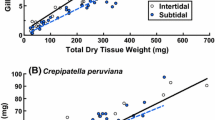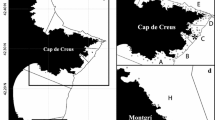Abstract
Curves relating instantaneous growth rate to aerial exposure were determined for six species of bivalves in laboratory and shore experiments. A dimensionless index equatable with the relative intertidal growth performance of a species was calculated by integration of the growth curve after converting both growth rate and aerial exposure to decimal fractions. Intertidal growth performance of the bivalves tested corresponded well with their natural levels of occurrence on the shore, and improved in the following order: Modiolus modiolus < Argopecten irradians < Ostrea edulis < Mytilus edulis < Crassostrea virginica. Geukensia demissa, for which an index value could not be determined, grew faster intertidally than subtidally. The relative contributions made to intertidal growth performance by energy-conserving and energy-supplementing capacity adaptations were assessed by resolving the growth curves into energy-input and energy-loss components. The rate of energy loss due to intertidal exposure was lower in the high-shore species, and also less affected by harsher subaerial conditions, than in the low-shore species. Moreover, M. edulis and C. virginica showed abilities to supplement energy input such that growth per unit immersion time was better at certain intertidal levels than subtidally. Energy conservation and supplementation in these forms made roughly equal contributions to their improved intertidal growth relative to species occurring lower on the shore.
Similar content being viewed by others
Literature Cited
Baird, R. H. and R. E. Drinnan: The ratio of shell to meat in Mytilus as a function of tidal exposure to air. J. Cons. perm. int. Explor. Mer. 22, 329–336 (1957)
Ballantine, D. and J. E. Morton: Filtering, feeding and digestion in the lamellibranch Lasaea rubra. J. mar. biol. Ass. U.K. 35, 241–274 (1956)
Bayne, B. L., C. J. Bayne, T. C. Carefoot and R. J. Thompson: The physiological ecology of Mytilus californianus Conrad. 2. Adaptations to low oxygen tension and air exposure. Oecologia (Berl.) 22, 229–250 (1976a)
Bayne, B. L., R. J. Thompson and J. Widdows: Physiology I. In: Marine mussels: their ecology and physiology, pp 121–206. Ed. by B. L. Bayne. London: Cambridge University Press 1976b
Boyden, C. R.: Aerial respiration of the cockle Cerastoderma edule in relation to temperature. Comp. Biochem. Physiol. 43A, 697–712 (1972a)
Boyden, C. R.: The behaviour, survival and respiration of the cockles Cerastoderma edule and C. glaucum in air. J. mar. biol. Ass. U.K. 52, 661–680 (1972b)
Coleman, N.: The oxygen consumption of Mytilus edulis in air. Comp. Biochem. Physiol. 45A, 393–402 (1973)
Coleman, N.: The aerial respiration of Modiolus modiolus. Comp. Biochem. Physiol. 54A, 401–406 (1976)
Helm, M. M. and E. R. Trueman: The effect of exposure on the heart rate of the mussel, Mytilus edulis L. Comp. Biochem. Physiol. 21, 171–177 (1967)
Higgins, E.: Progress in biological inguiries, 1939. Adm. Rept. 39, App. I, Rept. U.S. Comm. Fish. 1940, 1–96 (1940)
Jørgensen, C. B.: Growth efficiencies and factors controlling size in some mytilid bivalves, especially Mytilus edulis L.: a review and interpretation. Ophelia 15, 175–192 (1976)
Kuenzler, E. J.: Structure and energy flow of a mussel population in a Georgia salt marsh. Limnol. Oceanogr. 6, 191–204 (1961)
Langton, R. W.: Synchrony in the digestive diverticula of Mytilus edulis L. J. mar. biol. Ass. U.K. 55, 221–230 (1975)
Langton, R. W.: Digestive rhythms in the mussel Mytilus edulis. Mar. Biol. 41, 53–58 (1977)
Langton, R. W. and P. A. Gabbott: The tidal rhythm of extracellular digestion and the response to feeding in Ostrea edulis L. Mar. Biol. 24, 181–187, (1974)
Langton, R. W. and G. U. McKay: The effect of continuous versus discontinuous feeding on the growth of hatchery reared spat of Crassostrea gigas Thunberg. J. Cons. perm. int. Explor. Mer. 35, 361–363 (1974)
Langton, R. W. and G. U. McKay: Growth of Crassostrea gigas (Thunberg) spat under different feeding regimes in a hatchery. Aquaculture 7, 225–233 (1976)
Lent, C. M.: Air-gaping by the ribbed mussel, Modiolus demissus (Dillwyn): effects and adaptive significance. Biol. Bull. mar. biol. Lab., Woods Hole 134, 60–73 (1968)
Lewis, J. R.: The role of physical and biological factors in the distribution and stability of rocky shore communities. In: Biology of benthic organisms, pp 417–423. Ed. by B. F. Keegan, P. O. Ceidigh and P. J. S. Booden. New York: Pergamon Press 1977
Moore, M. N., D. M. Lowe and S. L. Moore: Induction of lysosomal destabilization in marine bivalve molluscs exposed to air. Mar. Biol. Lett. 1, 47–57 (1979)
Morton, J. E.: The tidal rhythm of feeding and digestion in the Pacific oyster, Crassostrea gigas (Thunberg). J. exp. mar. Biol. Ecol. 26, 135–151 (1977)
Morton, J. E.: The tidal rhythm and action of the digestive system of the lamellibranch Lasaea rubra. J. mar. biol. Ass. U.K. 35, 563–586 (1956)
Morton, J. E., A. D. Boney and E. D. S. Corner: The adaptations of Lasaea rubra (Montagu), a small intertidal lamellibranch. J. mar. biol. Ass. U.K. 36, 383–405 (1957)
Newell, R. C.: Effects of fluctuations in temperature on the metabolism of intertidal invertebrates. Am. Zool. 9, 293–307 (1969)
Newell, R. C.: Adaptations to intertidal life. In: Adaptation to the environment. Essays on the physiology of marine animals, pp 1–82. Ed. by R. C. Newell, Boston: Butterworths 1976
Newell, R. C.: Biology of intertidal animals, 781 pp. Faversham, Kent: Marine Ecological Surveys Ltd. 1979
Newell, R. C., V. I. Pye and M. Ahsanullah: Factors affecting the feeding rate of the winkle Littorina littorea. Mar. Biol. 9, 138–144 (1971)
Owen, G.: Lysosomes, peroxisomes and bivalves. Sci. Progr. 60, 299–318 (1972)
Pamatmat, M. M.: Anaerobic heat production of bivalves (Polymesoda caroliniana and Modiolus demissus) in relation to temperature, body size, and duration of anoxia. Mar. Biol. 53, 223–229 (1979)
Prosser, C. L.: Physiological adaptations in animals. In: Physiological adaptation to the environment, pp 3–18. Ed. by F. J. Vernberg. New York: Intext Educational Publishers 1975
Ritz, D. A. and D. J. Crisp: Seasonal changes in feeding rate in Balanus balanoides. J. mar. biol. Ass. U.K. 50, 223–240 (1970)
Schlieper, C.: Die Regulation des Herzschlages der Miesmuschel Mytilus edulis L. bei geöffneten und bei geschlossenen Schalen. Kiel. Meeresforsch. 11, 139–148 (1955)
Schlieper, C. and R. Kowalski: Ein zellularer Regulationsmechanismus für erhöhte Kiemenventilation nach Anoxybiose bei Mytilus edulis L. Kiel. Meeresforsch. 14, 42–47 (1958)
Seed, R. and R. A. Brown: Growth as a strategy for survival in two marine bivalves, Cerastoderma edule and Modiolus modiolus. J. Anim. Ecol. 47, 238–292 (1978)
Thompson, R. J., C. J. Bayne, M. N. Moore and T. H. Carefoot: Haemolymph volume, changes in biochemical composition of the blood, and cytological responses of the digestive cells in Mytilus californianus Conrad, induced by nutritional, thermal and exposure stress. J. comp. Physiol. 127, 287–298 (1978)
Vernberg, W. B. and F. J. Vernberg: Environmental physiology of marine animals, 346 pp. Berlin: Springer-Verlag 1972
Widdows, J., B. L. Bayne, D. R. Livingstone, R. L. E. Newell and P. Donkin: Physiological and biochemical responses of bivalve molluscs to exposure to air. Comp. Biochem. Physiol. 62A, 301–308 (1979)
Zar, J. H.: Biostatistical analysis, 620 pp. New Jersey: Prentice-Hall, Inc. 1974
Zwaan, A. de: Anaerobic energy metabolism in bivalve molluscs. Oceanogr. Mar. Biol. Ann. Rev. 15, 103–187 (1977)
Zwaan, A. de and T. C. M. Wijsman: Anaerobic metabolism in bivalvia (Mollusca). Characteristics of anaerobic metabolism. Comp. Biochem. Physiol. 54B, 313–324 (1976)
Author information
Authors and Affiliations
Additional information
Communicated by S. K. Pierce, College Park
Rights and permissions
About this article
Cite this article
Gillmor, R.B. Assessment of intertidal growth and capacity adaptations in suspension-feeding bivalves. Mar. Biol. 68, 277–286 (1982). https://doi.org/10.1007/BF00409594
Accepted:
Issue Date:
DOI: https://doi.org/10.1007/BF00409594




